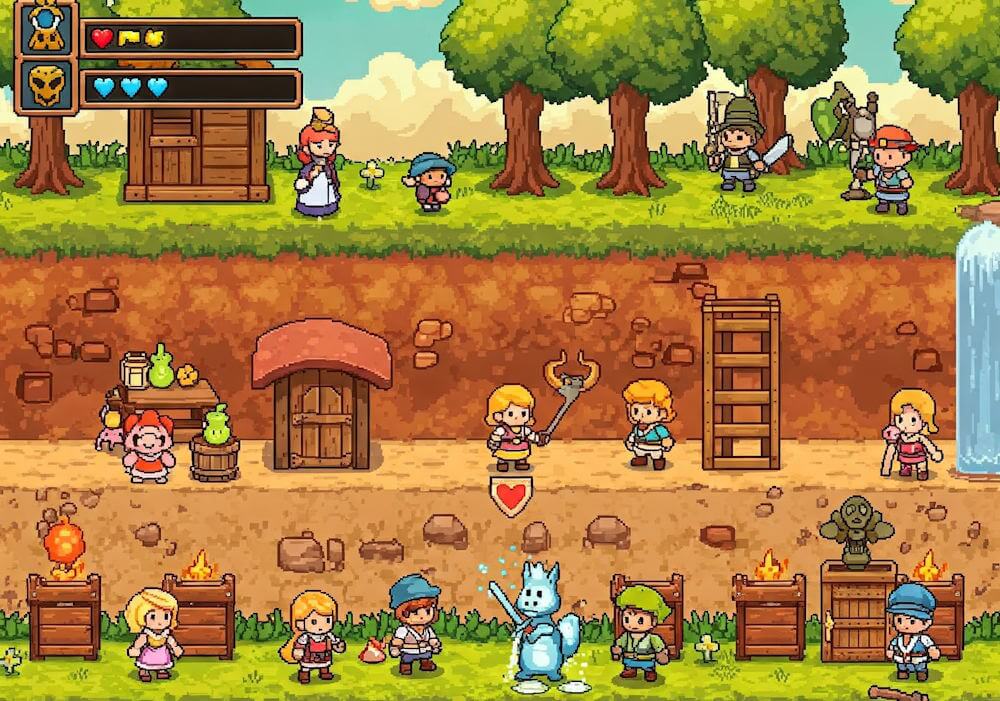‘The Last of Us Part II,’ developed by Naughty Dog, was released on June 19, 2020, as a sequel to the critically acclaimed first installment, ‘The Last of Us.’ This action-adventure game was made available for PlayStation 4, capturing the attention of gamers and critics within the industry. The anticipation surrounding its release was considerable, fueled by the success of its predecessor, which had set a high standard for storytelling in video games. ‘The Last of Us Part II’ sought to expand upon the emotional narrative and immersive world that players had come to appreciate, while also introducing new characters and deeper themes.
Themes of Revenge and Its Consequences
In ‘The Last of Us Part II’, the theme of revenge serves as a pivotal element that drives the narrative forward and profoundly influences the characters’ development. Throughout the game, the protagonist, Ellie, becomes fiercely consumed by the desire for vengeance after a traumatic event. This pursuit is not simply a plot device but rather a deep exploration of the psychological toll that revenge inflicts on an individual. As players witness Ellie navigate her path to retribution, it becomes evident that her quest is layered with anguish, loss, and moral dilemmas.
The narrative powerfully illustrates that the yearning for revenge often blinds individuals to the reality of their actions. Ellie’s transformation from a hopeful survivor into a relentless avenger highlights the moral implications that accompany her choices. Each step she takes to exact her retribution leads to a series of brutal confrontations, ultimately affecting not only her psyche but also the lives of those around her. The game successfully presents a cautionary tale regarding how the pursuit of vengeance can spiral into a cycle of violence, creating a ripple effect that damages multiple lives.
A significant aspect of the storytelling is how the consequences of revenge are not limited to physical harm but extend deeply into emotional and relational realms. Characters who are entangled in this cycle experience a range of negative outcomes, including isolation, betrayal, and a profound sense of emptiness. These elements serve to offer players a stark reflection on the costs associated with revenge, challenging preconceived notions of justice and morality. Through the rich narrative and emotional weight of ‘The Last of Us Part II’, the theme of revenge emerges as a multifaceted exploration of human nature, ultimately prompting players to question the true price of vengeance.
The Complexity of Characters
‘The Last of Us Part II’ presents a rich tapestry of characters, particularly focusing on Ellie and Abby, whose intricacies make them profoundly relatable despite their flaws. The narrative delves deeply into the psychological and emotional layers of these two individuals, showcasing their motivations and the events that shape their respective journeys. As players navigate through a post-apocalyptic world filled with moral dilemmas, they are invited to empathize with both characters, understanding that their actions stem from a blend of pain, revenge, and survival instincts.
Ellie, initially portrayed as a fierce and determined young woman, undergoes significant development throughout the game. Her desire for vengeance after a tragic loss propels her into a cycle of violence, raising questions about her morality and the cost of her quest for justice. Players witness Ellie’s struggle with her identity, grappling with the trauma she endures and the choices she makes. This complexity fosters a deep emotional connection, as players can relate to her internal conflicts, despite her regressions into vengeance-driven behavior.
Conversely, Abby serves as both an antagonist and a sympathetic character. Her backstory reveals motivations rooted in grief and the desire for redemption, complicating the binary notion of good and evil within the narrative. Through Abby, the game challenges players to reconsider preconceived notions of heroism and villainy, highlighting the impact of personal loss and the thirst for revenge. The creators meticulously craft her character arc to evoke understanding rather than outright condemnation, urging players to confront the messy realities of human emotions.
Ultimately, ‘The Last of Us Part II’ masterfully intertwines the stories of Ellie and Abby, promoting a nuanced perspective on the nature of empathy, vengeance, and the human experience. The depth of these characters not only captivates players but also compels them to ponder the very essence of morality in a world where survival often eclipses ethics.
The Role of Grief and Loss
In ‘The Last of Us Part II’, the themes of grief and loss are intricately woven into the narrative, elevating the emotional stakes of the gameplay experience. The game encapsulates the profound complexity of human emotions, particularly how characters navigate their pain and sorrow following traumatic events. Each character’s response to loss serves as a testament to the multifaceted nature of grief. For instance, Ellie’s journey is significantly shaped by the death of her loved ones, with her emotional trajectory illustrating the deep impact of personal loss on one’s psyche.
The game poignantly portrays how characters utilize varying coping mechanisms to confront grief. Some characters, like Ellie, engage in vengeance as a way to channel their sorrow, believing that retribution will provide a semblance of closure. Conversely, other characters exhibit more subdued responses, seeking solace in memories or community. This contrast highlights that grief does not have a universal expression; instead, it is deeply personal and shaped by individual experiences. Moreover, the realization that grief can manifest in diverse forms—such as anger, despair, or numbness—underscores the complexity of healing from such emotional wounds.
Additionally, the long-lasting effects of trauma are continually evidenced throughout the game. The narrative progression allows players to witness the characters’ struggles as they attempt to process their experiences and emotions. This emphasis on psychological depth aligns with real-world understandings of grief, emphasizing the importance of emotional processing and the potential need for healing. By illustrating how trauma can linger and affect one’s actions and relationships, ‘The Last of Us Part II’ creates a dialogue around the necessity of addressing grief rather than merely enduring it. Ultimately, the game serves as a reminder of the bittersweet nature of human connection, impacted profoundly by loss.
The Importance of Perspective
In ‘The Last of Us Part II,’ the innovative use of multiple perspectives stands out as a crucial storytelling technique. By allowing players to engage with the narrative through the eyes of various characters, the game cultivates a deeper understanding of the complexities inherent in human relationships. This multifaceted approach to storytelling challenges traditional narratives, where players typically remain loyal to a single protagonist. Instead, by adopting different viewpoints, players are urged to reevaluate their perceptions and judgments of characters, enriching their overall gaming experience.
The shifting perspectives are integral to the game’s exploration of themes such as revenge, loss, and redemption. For instance, players transition between the two central characters, Ellie and Abby, each grappling with their own traumas and motivations. This dual narrative not only enhances the emotional depth of the story but also encourages players to empathize with characters whose actions they may initially find objectionable. By directly experiencing the events and choices of both characters, players are prompted to reflect on the moral complexities that each situation entails.
This technique of presenting multiple perspectives facilitates a broader understanding of the game’s intricate world. Players come to appreciate that actions are often influenced by context, experiences, and the unique perspectives of the individuals involved. Consequently, the narrative invites players to confront their own biases and judgments, fostering a greater sense of empathy. In a world increasingly marked by polarization, ‘The Last of Us Part II’ illustrates the importance of considering various viewpoints, reminding players that their interpretations of events are often just one part of a larger, multifaceted reality. This vital aspect of gameplay not only enhances player engagement but also serves as a poignant commentary on the nature of humanity itself.
Moral Ambiguity in Decision Making
‘The Last of Us Part II’ presents a compelling exploration of moral ambiguity that resonates deeply with players, challenging them to confront complex ethical dilemmas. Throughout the narrative, players are confronted with scenarios where the line between right and wrong becomes increasingly blurred, prompting introspection about their own values and beliefs. The characters are placed in situations that require them to make difficult choices, often with far-reaching implications that extend beyond personal consequences.
One of the most striking elements of the game is the portrayal of revenge and its ramifications. The protagonist, Ellie, embarks on a journey fueled by a desire for retribution, which not only shapes her actions but also highlights the cycle of violence that evolves from such decisions. This thematic representation urges players to consider the morality of their choices and the potential consequences that arise from a singular focus on vengeance. The game effectively illustrates that motivations can be both relatable and troubling, exhibiting how justifiable intentions can lead to devastating outcomes.
Moreover, the relationships between characters further complicate these moral landscapes. Allies and adversaries are not clearly delineated; instead, each character possesses multifaceted identities that provoke empathy and conflict within the player. For instance, the interactions between Ellie and her opponents reveal that they too harbor their own struggles and reasons for their actions. This nuanced portrayal reinforces the notion that morality is subjective and contextual, leaving players to grapple with the discomfort of their choices.
Ultimately, ‘The Last of Us Part II’ functions as a mirror reflecting the intricate nature of human morality, compelling players to question their beliefs while navigating through a world devoid of absolute answers. The moral ambiguity portrayed throughout the game serves as a poignant reminder that ethical decision-making often resides in a gray area rather than clear absolutes.
Exploration of Relationships and Connections
In ‘The Last of Us Part II’, the exploration of relationships and connections plays a pivotal role in delivering a profound narrative experience. The game offers a diverse range of relationships that encompass friendships, familial bonds, and romantic connections, each contributing to character development and emotional depth. These interactions provide a lens through which players can understand not only the motivations behind characters’ actions but also the overarching themes of the story.
One of the most significant relationships is that between Ellie and Joel, which evolves throughout the game. Their bond, marked by complex emotions of trust, love, and betrayal, drives much of the narrative. Players witness how their histories shape their decisions, leading to pivotal moments that highlight the duality of human connection—both a source of strength and vulnerability. As Ellie faces the aftermath of Joel’s actions, her relationships with others, such as Dina and Abby, further illustrate the impact of love and loss. Each character’s journey reflects the multitude of ways humans navigate their connections amid adversity.
The portrayal of friendships is equally compelling, particularly through the relationship between Ellie and Dina. Their bond serves as a beacon of hope, showcasing the joy and solace that can be found in companionship during dark times. This friendship also underscores how relationships can provide support and motivation in the face of tragedy. Alternatively, the strained relationship between Abby and her father presents a cautionary perspective on how connections, when marred by misunderstanding or pain, can shape a person’s destiny and influence their actions.
Through these intricate relationships, ‘The Last of Us Part II’ reinforces the necessity of human interaction in both joyous and despairing circumstances. Each character’s connection to one another is essential, ultimately illustrating that the essence of humanity lies in our ability to relate, love, and sometimes lose.
The Impact of Environment and Setting
The environment and setting in ‘The Last of Us Part II’ are integral to its narrative depth, enhancing the storytelling through a meticulously crafted post-apocalyptic landscape. This immersive world-building is not merely aesthetic; it serves as a critical backdrop that influences character behavior and drives plot progression. The game’s environments, from overgrown urban areas to dilapidated rural homes, encapsulate a sense of loss and survival that resonates with players.
As players navigate through these richly detailed surroundings, they encounter remnants of a once-thriving civilization, which evoke feelings of nostalgia and melancholy. This serves to heighten empathy for the characters, as their struggles are framed within the context of a world irrevocably altered by catastrophe. Each location tells its own story, revealing the harsh realities and emotional burdens carried by the survivors. The environmental storytelling offers subtle cues concerning the fate of societies and individuals, encouraging players to reflect on the broader implications of human survival.
The game’s setting also plays a pivotal role in shaping character interactions. For instance, the hostile terrains often force characters into confrontational scenarios where their moral compasses are tested. This dynamic can either bring individuals closer or deepen existing rifts, reflecting the psychological impact of the world around them. The stark contrasts between safe haven and danger amplify the emotional stakes, making the characters’ decisions more impactful. Through this intricate relationship between environment and character, ‘The Last of Us Part II’ underscores the notion that our surroundings can profoundly influence our choices and relationships, illustrating the essence of survival in a fractured world.
Conclusion: Reflections and Future Implications
The narrative and thematic depth of ‘The Last of Us Part II’ provide critical insights into the complex nature of humanity, morality, and empathy. Throughout the game, players are confronted with the often gray moral landscape that defines human conflict. The decisions made by characters reveal profound lessons about the consequences of vengeance, the burden of grief, and the quest for redemption. This intricate storytelling goes beyond mere entertainment; it invites players to reflect on their moral choices and the impact of their actions on others.
One of the key lessons from the game is the portrayal of the cyclical nature of violence. The characters’ journeys highlight how revenge often leads to a cycle that perpetuates pain and suffering, rather than bringing closure or peace. This reinforces the importance of empathy and understanding in our interactions with others, both in the gaming world and in real life. The emotional weight carried by the game’s protagonists serves as a reminder that every action has repercussions, encouraging a deeper consideration of our ethical responsibilities.
Furthermore, ‘The Last of Us Part II’ demonstrates the importance of narrative diversity in gaming. By showcasing a broad range of experiences and perspectives, the game enriches the medium, allowing for greater representation of voices that reflect real-world complexities. This can influence the future of storytelling in video games, encouraging developers to embrace nuanced narratives that challenge societal norms and provoke critical thought among players.
As we reflect on the lessons learned from ‘The Last of Us Part II,’ it becomes clear that the evolution of storytelling in gaming has significant implications for players and creators alike. The game’s exploration of humanity’s darker aspects serves as a poignant reminder of the potential that video games have to inspire empathy, introspection, and meaningful conversations about the world we inhabit.




